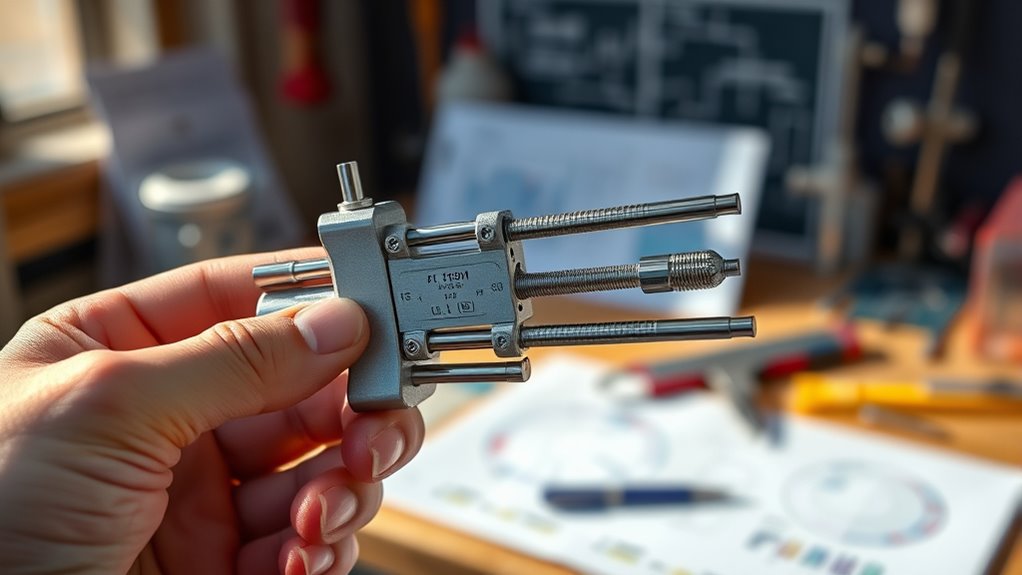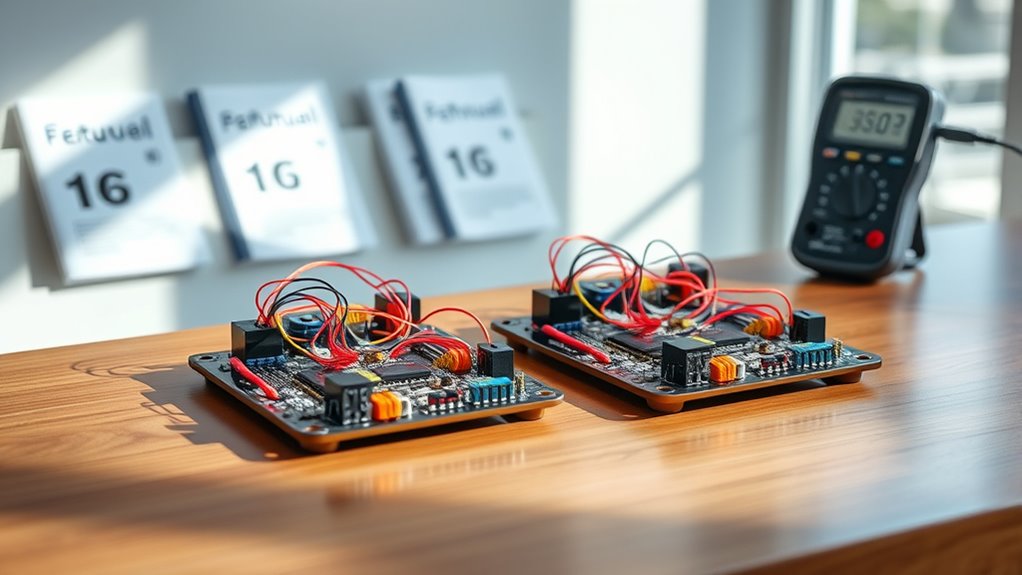Parallel kits connect batteries or electrical parts side by side, doubling capacity and ensuring consistent power flow. Many myths suggest they automatically double battery life or are unsafe, but proper installation is key. These kits improve system efficiency and safety when used correctly. Understanding the differences from other wiring methods helps you choose the right setup. If you want clear explanations and facts to make informed decisions, you’ll find even more useful details ahead.
Key Takeaways
- Parallel kits connect batteries to increase capacity and reliability without changing voltage.
- Proper installation and wiring are essential for safety, efficiency, and preventing electrical issues.
- Myths include that parallel kits automatically double battery life; actual benefits depend on correct setup.
- Parallel kits are generally safe when used with compatible components and installed correctly by professionals.
- Choosing the right kit involves matching it to your vehicle’s electrical needs and following proper wiring practices.
What Are Parallel Kits and How Do They Work?

Ever wonder how parallel kits boost your vehicle’s performance? These kits are designed to connect multiple batteries or components in parallel, increasing power capacity and reliability. To set them up properly, you’ll need wiring diagrams that show how to connect the batteries or devices safely. The installation procedures involve attaching the positive terminals together and the negative terminals together, ensuring a secure and balanced connection. This setup allows current to flow evenly, giving your vehicle more consistent power and improving overall efficiency. Proper wiring diagrams are essential to avoid mistakes that could cause electrical issues. By following clear instructions and correct wiring methods, you guarantee your parallel kit works effectively, enhancing your vehicle’s performance without risking damage or safety hazards. Understanding battery wiring configurations is crucial for a safe and effective installation.
Common Misconceptions About Parallel Kits

Many people believe that installing a parallel kit automatically doubles your vehicle’s battery life or power output, but that’s not always the case. Installation challenges can arise, especially if your vehicle isn’t compatible or if you’re unfamiliar with proper wiring. Some think that a parallel kit voids your warranty, but this depends on the manufacturer and how the installation is done. To clarify, here’s a quick comparison:
| Misconception | Reality | Key Concern |
|---|---|---|
| Doubles battery life or power | It improves efficiency but not guaranteed to double | Warranty concerns vary |
| Installation is simple | Proper installation can be complex and challenging | Installation challenges |
| Voids warranty automatically | Not necessarily; check your manufacturer’s policy | Warranty concerns |
Additionally, understanding vehicle electrical systems can help you make informed decisions when considering parallel kits.
The Benefits of Using Parallel Kits

Have you considered how a parallel kit can enhance your vehicle’s electrical system? Using one allows you to improve electrical efficiency by distributing power more effectively across batteries or components. This makes vehicle customization easier, as you can add batteries or upgrade existing ones without overloading your system. Parallel kits also help maintain consistent voltage levels, reducing the risk of electrical issues. They simplify wiring configurations, making upgrades straightforward even for DIY enthusiasts. Additionally, they support increased power capacity, which is essential for high-demand accessories or aftermarket modifications. Properly configured, parallel kits can maximize power output and improve overall system reliability. Overall, a parallel kit provides a reliable way to boost your vehicle’s electrical performance, ensuring your system operates smoothly and efficiently while allowing for flexible customization options.
Are Parallel Kits Safe to Use?

While parallel kits are generally safe when installed correctly, it’s important to understand that improper wiring or incompatible components can pose risks. If you don’t follow the instructions carefully, you might cause electrical issues or damage your vehicle’s electrical system. Ensuring brand compatibility is essential; using a kit designed specifically for your vehicle’s make and model reduces the risk of malfunction. Proper installation also helps maintain vehicle aesthetics, keeping your setup neat and professional-looking. When in doubt, consult a professional to verify that the parallel kit matches your vehicle’s specifications. Additionally, understanding electrical safety and proper wiring techniques can help prevent potential hazards. Overall, if installed correctly and with compatible parts, parallel kits are safe and a reliable way to enhance your vehicle’s lighting system.
How to Choose the Right Parallel Kit for Your Needs

To choose the right parallel kit, start by checking if it’s compatible with your vehicle. Next, identify your power requirements to guarantee the kit meets your needs. Finally, balance your budget with quality to find the best option without overspending. Considering the refrigeration cycle can also help ensure the kit functions efficiently and reliably over time.
Assess Your Vehicle Compatibility
Choosing the right parallel kit starts with understanding your vehicle’s specifications. First, check your vehicle’s electrical capacity to verify it can handle the additional load. A larger or more powerful vehicle battery may be necessary if you plan to draw significant power. Measure your battery’s voltage and current limits to avoid overloading your system. Confirm that your vehicle’s wiring and existing electrical components can support the parallel kit’s connections. Compatibility also depends on the size and type of your battery, so verify that the kit is designed for your specific model. Ensuring proper Audi Tuning compatibility can prevent potential electrical issues or damage. Failing to take into account these factors could lead to electrical issues or damage. By evaluating your vehicle’s electrical capacity and battery specifications, you ensure a seamless fit and safe operation of your parallel kit.
Determine Your Power Needs
How do you determine the right parallel kit for your needs? First, you need to perform a power calculation to estimate your vehicle’s energy requirements. This helps you understand how much additional power you’ll need from a parallel kit. Next, consider your typical usage—are you running accessories, upgrading for better performance, or both? Then, check your current system’s capacity to avoid overloading. Finally, match these insights with the kit’s specifications—ensure it can handle your calculated energy demands comfortably. Additionally, reviewing Vetted – Grobal World information on diverse designs and materials can help you select a kit that complements your vehicle’s setup. By evaluating your energy requirements carefully, you’ll choose a parallel kit that reliably meets your needs without wasting money or risking system stability. This thoughtful approach guarantees you get the right fit for your vehicle’s power needs.
Consider Budget and Quality
Once you’ve determined your vehicle’s power requirements, it’s important to balance your budget with the quality of the parallel kit you select. Your budget considerations influence your options, but quality assurance guarantees safety and durability. Skimping on quality may save money upfront but can lead to frequent replacements or failures. To help decide, consider this:
| Budget Range | Quality Assurance Focus |
|---|---|
| Low | Basic components, shorter lifespan |
| Medium | Reliable parts, decent durability |
| High | Premium materials, long-term reliability |
Choosing a higher-quality kit often costs more but provides peace of mind and better performance. Prioritize quality assurance to match your needs and avoid costly mistakes later. Additionally, understanding the types of parallel kits can help you make an informed decision.
Installation Tips for Parallel Kits

Proper installation is essential to guarantee your parallel kit functions safely and efficiently. Follow these installation tips to ensure a smooth process. First, always double-check your wiring connections, following wiring best practices to prevent shorts or loose contacts. Second, use the correct gauge wire recommended for your setup to handle the current safely. Third, secure all wiring neatly to avoid contact with moving parts or heat sources. Fourth, test your system before full operation, making sure all connections are tight and functioning properly. Taking these steps helps prevent issues and maximizes performance. Remember, careful wiring and attention to detail are key. Proper installation not only enhances safety but also prolongs the lifespan of your parallel kit. Additionally, understanding the specific application, such as the type of tuning your vehicle requires, can help optimize the setup for better results.
Differences Between Parallel Kits and Other Wiring Methods

Understanding how wiring configurations differ is key to choosing the right method for your needs. Parallel kits typically offer better safety and efficiency compared to series wiring, but they vary in complexity. A high refresh rate can significantly improve performance in applications like gaming or high-speed video playback. Let’s explore how these differences impact performance and installation.
Wiring Configuration Variations
Have you ever wondered how different wiring configurations affect the performance of your solar kit? Wiring configuration variations influence how your system delivers power and manages the battery setup. With parallel kits, the wiring diagrams usually keep voltage steady while increasing current. Here are some differences to contemplate:
- Battery configuration – Parallel wiring maintains voltage but boosts capacity, ideal for larger power needs.
- Series wiring – Increases voltage but keeps capacity the same, suitable for specific applications.
- Mixed wiring – Combines series and parallel, offering customized voltage and capacity.
- Wiring diagrams – Visual guides help you see how each configuration impacts performance and safety.
Understanding these variations ensures you choose the right wiring setup for your solar needs, maximizing efficiency and longevity.
Safety and Efficiency
When comparing wiring methods, safety and efficiency are key factors to contemplate. Parallel kits often enhance battery performance by providing consistent power flow, reducing the risk of overloads. They ensure wiring safety by distributing current evenly, preventing overheating or damage to your batteries and wiring components. Unlike series wiring, which can cause voltage drops and potential safety hazards, parallel configurations maintain stable voltage levels, improving overall system reliability. This means your setup operates more effectively, with less risk of failure or fire. Using parallel kits simplifies installation and maintenance, making your system safer and more dependable. Ultimately, choosing a wiring method that prioritizes safety and efficiency helps protect your investment and guarantees optimal performance over time.
Troubleshooting Common Issues With Parallel Kits

Troubleshooting common issues with parallel kits can be straightforward if you know what to look for. First, check the battery capacity; mismatched batteries can cause uneven charging and reduce overall performance. Second, inspect the wiring durability—frayed or loose connections often lead to power loss or intermittent operation. Third, ensure all connections are tight and properly insulated to prevent short circuits. Fourth, verify the wiring layout matches the kit’s specifications, as incorrect wiring can cause overloading or damage. Addressing these issues promptly helps maintain maximum performance and prolongs your kit’s lifespan. Regularly inspecting battery health and ensuring durable wiring can prevent many common problems, saving you time and repair costs later.
Myths About the Cost and Maintenance of Parallel Kits

Many people believe that parallel kits are expensive to maintain and require constant, costly upkeep, but this isn’t necessarily true. These cost misconceptions often stem from misunderstandings about how parallel kits operate and their long-term durability. In reality, maintenance myths suggest they’re more complicated than they are. Most parallel kits are designed for easy installation and simple upkeep, reducing ongoing costs. Regular checks and basic maintenance typically suffice to keep them functioning well, without breaking the bank. The truth is, these kits can be quite affordable to maintain, especially when properly installed and cared for. So, don’t let false assumptions about expense discourage you from considering a parallel kit as a practical, cost-effective solution.
Frequently Asked Questions
Can Parallel Kits Be Used With All Types of Batteries?
Parallel kits can be used with many types of batteries, but their compatibility depends on the specific battery chemistry and voltage requirements. You should check the battery compatibility and confirm the kit’s design matches your batteries’ specifications. While parallel kits offer kit versatility for different setups, always verify that the kit suits your battery type to prevent damage or safety issues. Proper matching guarantees safe and effective performance.
How Long Do Parallel Kits Typically Last?
Parallel kits typically last between 3 to 5 years, depending on usage and maintenance. Imagine your battery lifespan stretching longer because of a durable kit that withstands daily wear and tear; that’s what quality parallel kits offer. Proper care and regular checks can extend their durability, ensuring your setup remains reliable. So, investing in a sturdy parallel kit can keep your batteries running smoothly for years to come.
Are There Any Environmental Considerations When Using Parallel Kits?
When using parallel kits, you should consider environmental impacts like battery recycling and eco-friendly materials. Guarantee you recycle batteries properly to prevent harmful waste. Opt for kits made with eco-friendly materials to reduce your carbon footprint. Proper disposal and choosing sustainable components help protect the environment. Being mindful of these factors allows you to enjoy the benefits of parallel kits without contributing to pollution or resource depletion.
Can Parallel Kits Improve the Overall System Performance?
They say, “A chain is only as strong as its weakest link,” and parallel kits can boost your system’s performance by increasing battery capacity and ensuring voltage stability. By connecting batteries in parallel, you distribute the load more evenly, reducing strain on individual units. This setup can enhance overall efficiency, extend lifespan, and provide more reliable power, helping your system perform better under demanding conditions.
What Are the Signs Indicating a Parallel Kit Needs Replacement?
You’ll know your parallel kit needs replacing if you notice a drop in battery capacity, causing shorter device usage times. Poor connection quality can also be a sign, leading to intermittent power or device malfunctions. If you experience frequent disconnections or inconsistent performance, it’s time to contemplate a replacement. Regularly check these signs to guarantee your system runs smoothly, preventing unexpected failures and maintaining ideal performance.
Conclusion
Now that you know the facts, you can confidently choose, install, and maintain your parallel kit. You can separate myths from truths, understand the benefits over drawbacks, and select the right kit for your needs. You can guarantee safety and efficiency, troubleshoot issues with ease, and keep your system running smoothly. With this knowledge, you’re empowered to make smart decisions, avoid common mistakes, and enjoy the full advantages of parallel kits every step of the way.









